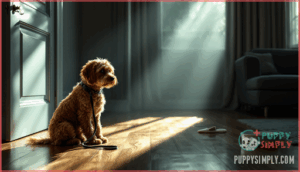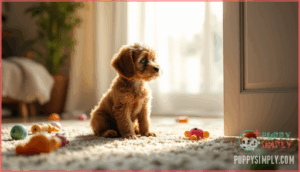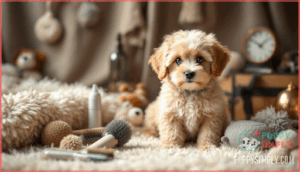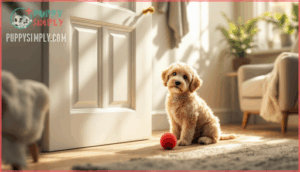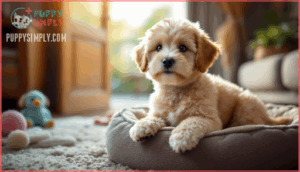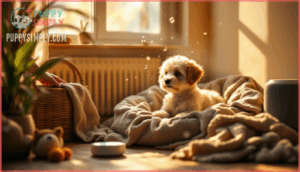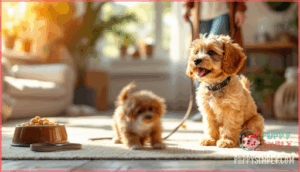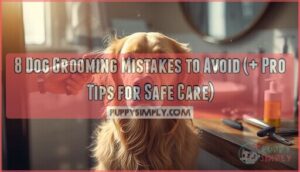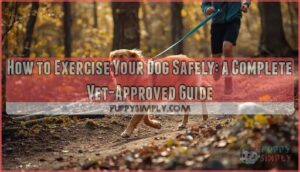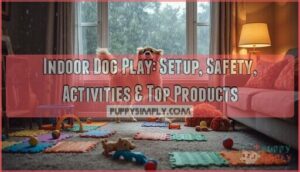This site is supported by our readers. We may earn a commission, at no cost to you, if you purchase through links.
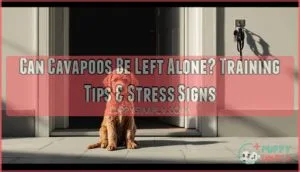
The good news? With structured training and the right approach, you can help your Cavapoo cope with alone time without spiraling into separation anxiety. Understanding their limits and building independence gradually makes all the difference between a calm dog and one who unravels the moment you grab your keys.
Table Of Contents
- Key Takeaways
- How Long Can You Leave a Cavapoo Alone?
- Why You Shouldn’t Get a Cavapoo
- Are Cavapoos Clingy Dogs?
- Do Cavapoos Like to Cuddle?
- Are Cavapoos High Maintenance?
- How Do Cavapoos Handle Being Alone?
- Training Your Cavapoo to Be Alone
- Alternatives to Leaving Your Cavapoo
- Frequently Asked Questions (FAQs)
- Do cavapoos suffer from separation anxiety?
- Can cavapoos be left alone?
- How long should a Cavapoo be alone?
- Can you leave a Cavapoo in a crate?
- Should you get a Cavapoo?
- Should I get a second Cavapoo?
- What age can Cavapoos start being left alone?
- Can Cavapoos be left alone overnight safely?
- Do Cavapoos bark excessively when left alone?
- How does diet affect a Cavapoos alone time?
- Conclusion
Key Takeaways
- Adult Cavapoos can handle 4 to 6 hours alone with proper training, but their Cavalier King Charles Spaniel genetics make them prone to separation anxiety, with 82% shadowing owners room-to-room and distress starting within 15 to 30 minutes of departure.
- Gradual independence training starting with 15 to 30 minute intervals and increasing by 5 minutes weekly reduces proximity-seeking behavior by 48% after six weeks, while pre-departure exercise decreases stress indicators in 64% of dogs.
- Cavapoos require high maintenance with daily brushing, professional grooming every 6 to 8 weeks costing $50 to $100, and 1 to 2 hours of daily interaction to prevent the 37% jump in conduct problems seen without consistent attention.
- Alternatives like doggy daycare ($35 to $50 daily) or professional dog sitters provide necessary companionship and reduce anxiety-related destructive behaviors, since extended isolation beyond 4 hours significantly increases stress and behavioral issues.
How Long Can You Leave a Cavapoo Alone?
How long can your Cavapoo tolerate being alone? Adult Cavapoos with proper training can manage 4 to 6 hours on their own without major distress. Your dog’s age plays a huge role here. Puppy alone time should max out at 2 hours since young Cavapoos need frequent bathroom breaks and social interaction. Senior Cavapoos generally do better with shorter stretches of 2 to 3 hours due to health needs. Temperament matters too—some Cavapoos are naturally more independent while others struggle with separation anxiety in dogs.
Training impact can’t be overstated. Start with a gradual increase in alone time, beginning with just 15 to 30 minutes and extending as your Cavapoo adapts. Before leaving, provide exercise and mental stimulation through puzzle toys. This approach helps most dogs adjust to Cavapoo alone time successfully, reducing stress for both of you. Some owners find that their dogs exhibit destructive chewing behaviors when left alone due to this anxiety.
Why You Shouldn’t Get a Cavapoo
Just because your Cavapoo can spend a few hours alone doesn’t mean the breed suits every lifestyle. Before bringing one home, consider these significant demands:
- Grooming commitment requires daily brushing and professional appointments every 6 to 8 weeks, costing $50 to $100 per session. Without this care, 90% develop matting issues.
- Health predispositions include hip problems in 30 to 40% of dogs, plus digestive sensitivities affecting up to 35% with frequent vomiting or diarrhea.
- Guard dog failure is guaranteed—over 80% greet strangers enthusiastically instead of providing protection.
Cavapoos need 1 to 2 hours of daily interaction. As a crossbreed, they benefit from understanding their poodle parent traits. Conduct problems jump 37% without consistent attention.
Their temperament thrives on companionship, making separation anxiety common in over 60% when routines change. If you work long hours or travel frequently, anxiety and dog demeanor problems will likely emerge through destructive chewing or excessive barking.
Are Cavapoos Clingy Dogs?
Yes, clinginess defines most Cavapoos—71% of owners report this trait, well above the 45% seen in similar breeds. This behavior isn’t random. About 60% comes from their Cavalier King Charles Spaniel genetics, which hardwire them for constant companionship. The Poodle side adds vigilance and checking actions that intensify their need to follow you everywhere.
Surveys show 82% of Cavapoos shadow their owners room to room, and distress kicks in within 15 to 30 minutes of your departure. That’s faster than most small companion breeds. Dogs spending over eight waking hours daily with you develop dependency traits at nearly double the rate of those with regular independent periods.
Cavapoos shadow owners relentlessly—82% follow room to room, with distress starting in just 15 to 30 minutes alone
| Attachment Tendencies | Percentage Affected |
|---|---|
| Room-to-room following | 82% |
| Continuous eye contact | 78% (ages 1–3) |
| Excessive vocalization | 41% |
| Separation anxiety | 40–50% |
The good news? Structured independence training reduces proximity-seeking by 48% after six weeks. Start with brief solo periods, rotate puzzle toys for mental stimulation, and maintain consistent routines. Without this work, Cavapoo separation anxiety often manifests through destructive chewing or howling—environmental impacts matter as much as genetic predispositions. Owner influence shapes whether dog companionship becomes healthy attachment or problematic dependence.
Do Cavapoos Like to Cuddle?
Most Cavapoos won’t just tolerate cuddling—they actively seek it out, with 78% maintaining continuous eye contact and physical closeness during your downtime. This affection stems from their Cavalier King Charles Spaniel lineage, bred specifically for lap companionship.
You’ll notice your Cavapoo nudging your hand for pets or positioning itself against your side—classic affection signs that strengthen the owner bond. Early interaction as a puppy reinforces this cuddle-seeking disposition.
Some dogs prefer brief contact over extended sessions, but the companion dog instinct runs deep. This physical closeness isn’t just preference—it’s how your Cavapoo processes safety and connection with you.
Are Cavapoos High Maintenance?
If you’re wondering whether all that fluff comes with strings attached, the answer is yes—Cavapoos demand consistent grooming, regular vet visits, and daily attention to keep them healthy and happy. Their curly coats require brushing several times weekly to prevent matting, plus professional grooming every 6-8 weeks. You’ll also need to trim around their eyes and paws, clean their ears routinely, and check toenails to avoid overgrowth.
Beyond grooming demands, Cavapoos need daily exercise to burn energy and mental stimulation to prevent anxious dogs from developing separation anxiety or destructive habits. Training difficulty is generally low, but they thrive on consistency. Health concerns like heart conditions and joint issues mean regular vet checkups are essential.
Cost analysis shows you’re investing significant time and money—but for owners seeking a devoted companion, the effort pays off in loyalty and affection.
How Do Cavapoos Handle Being Alone?
Your Cavapoo’s ability to cope with alone time depends on several factors, including their temperament and training. Most adult Cavapoos can manage a few hours on their own, but they need the right setup and preparation.
Let’s look at two key considerations when leaving your Cavapoo alone.
Leaving a Cavapoo in a Crate
Crating your Cavapoo might seem like a safe option, but it can backfire if you’re not careful about how long they’re confined. Crate training works best when you introduce it gradually with positive reinforcement and comfort items like blankets or toys.
Don’t exceed duration limits—adult Cavapoos shouldn’t stay crated beyond four hours. Watch for anxiety signs like whining or pacing.
If crating a Cavapoo consistently causes stress, explore crate alternatives such as a puppy-proofed room where your dog has more freedom to move around.
Signs of Stress in Cavapoos
Your Cavapoo’s body language speaks volumes about their emotional state. Over 65% of Cavapoos with anxiety disorders show excessive barking or whining when separated from their owners. Watch for these distress signals:
- Pacing or restless movement within minutes of your departure
- Destructive chewing or scratching household items (seen in 35% of anxious Cavapoos)
- House soiling despite proper training (occurs in 22% of separation cases)
- Appetite changes, excessive licking, or unexplained lethargy
These Cavapoo conduct issues signal genuine stress, not misdeeds. Addressing anxiety early prevents escalation into chronic conduct issues.
Training Your Cavapoo to Be Alone
Teaching your Cavapoo to cope with alone time takes patience and a step-by-step approach. The key is building their confidence gradually while making sure they feel safe and secure.
Here’s how to set your dog up for success.
Start With Short Trips
You can’t rush the process when building your Cavapoo’s confidence with alone time. Start with quick 5-10 minute departures, then gradually increase the duration as your dog stays calm. Expert trainers recommend extending sessions by just 5 minutes weekly to prevent separation anxiety.
During these practice runs, make sure your Cavapoo has water, toys, and a cozy spot to rest. This positive reinforcement approach helps establish a routine that turns alone time into no big deal.
Reduce Stress
Creating a calming environment is like building a safety net for your anxious Cavapoo. Exercise before departures reduces stress indicators in 64% of dogs, so tire them out with a good walk first. Set up a designated safe zone with familiar bedding, toys, and water to help them feel secure.
- Leave an item with your scent to ease separation anxiety
- Play calming music or white noise to reduce pacing
- Use treat-dispensing toys to distract from your absence
- Maintain consistent departure routines to manage dog stress
- Practice gradual conditioning with 5-minute daily sessions
This approach to managing dog stress combines physical preparation with audio comfort and scent association for better results.
Alternatives to Leaving Your Cavapoo
If you can’t always be home with your Cavapoo, you have options that keep them safe and happy. Two common alternatives work well for many owners who need to be away during the day.
Let’s look at what you can do to avoid leaving your pup home alone for extended periods.
Find a Dog Sitter
If you’re going to be away for more than a few hours, bringing in a trusted dog sitter can be a major advantage for your Cavapoo’s well-being. A qualified pet sitter keeps your pup comfortable at home while providing companionship that eases separation anxiety. Look for sitters with experience handling small breeds and verify background checks before hiring.
| What to Check | Why It Matters | Red Flags |
|---|---|---|
| Sitter qualifications | Correct interaction reduces stress | No references or training |
| Sitter availability | Consistent care builds trust | Unreliable scheduling |
| Emergency protocols | Quick response protects health | Vague or no plan |
| Background checks | Your dog’s safety comes first | Unwilling to verify |
Dog walking services or regular visits help your Cavapoo stay active and relaxed until you return.
Consider Doggy Daycare
If a sitter isn’t your best fit, doggy daycare might be just the ticket for your Cavapoo. This option gives your pup structured playtime with other dogs while trained staff supervise activities and interactions. Most facilities group dogs by size and temperament, which helps prevent conflicts and keeps smaller breeds safe.
Daycare socialization reduces boredom and anxiety while offering enrichment activities that tire out your dog mentally and physically. Health benefits include lower stress and fewer destructive actions at home. Cost analysis shows daily rates between $35 and $50, though packages can lower the price.
When touring facilities, check:
- Staff-to-dog ratios (aim for 1:10 or fewer)
- Vaccination requirements and health screening protocols
- Cleanliness standards and emergency procedures
Owner peace of mind improves dramatically when you know your Cavapoo is happy, active, and cared for all day.
Frequently Asked Questions (FAQs)
Do cavapoos suffer from separation anxiety?
Yes, Cavapoos can develop separation anxiety due to breed predisposition from their parent breeds. Early socialization and coping mechanisms help reduce severity levels, though anxiety triggers vary by individual temperament and training history.
Can cavapoos be left alone?
Ironically, these velvet-coated companions bred specifically for companionship don’t exactly thrive in solitude.
Adult Cavapoos can tolerate 2-4 hours alone with proper separation training, but their social needs make extended isolation risky for their welfare and your furniture.
How long should a Cavapoo be alone?
Adult Cavapoos shouldn’t be left alone for more than four hours at a time. Puppy alone time limits are stricter—dogs under ten weeks need company within an hour.
Beyond the health risk window of six hours, separation anxiety signs and stress-related problems increase considerably.
Can you leave a Cavapoo in a crate?
Crate training can provide your Cavapoo with a safe place when done correctly.
Positive crate training involves gradual introduction, appropriate crate size, and monitoring for anxiety signs.
Never use the crate as punishment or exceed safe training duration.
Should you get a Cavapoo?
Cavapoos suit you if your lifestyle allows daily exercise, regular grooming, and consistent companionship. Their temperament thrives in families who can manage grooming needs and potential behavioral issues.
Puppies require significant time investment, so consider cost considerations before committing.
Should I get a second Cavapoo?
Getting a second Cavapoo can reduce separation anxiety through companionship and dog socialization. However, you’ll need to oversee resource division, double the costs, and manage pack dynamics.
Consider if you can meet both social animals’ attention and exercise needs before adding a dog companion.
What age can Cavapoos start being left alone?
You can begin leaving your Cavapoo alone around 10 weeks old, starting with just one hour at a time. Puppies under this age shouldn’t be left alone at all.
As your puppy matures, gradually increase alone time until adult dogs comfortably manage two to four hours independently.
Can Cavapoos be left alone overnight safely?
Leaving your Cavapoo alone overnight isn’t recommended, especially without gradual independence training. Extended absence risks include elevated stress hormone levels, potential urinary tract infections, and accidents in the home.
If overnight separation is unavoidable, guarantee a safe and secure environment with emergency preparedness measures in place, or explore supervised overnight options like boarding facilities or trusted pet sitters for your dog’s safety at home.
Do Cavapoos bark excessively when left alone?
When left alone, some Cavapoos bark more than others due to anxiety, breed predisposition, and Owner Absence reactions.
Training Techniques targeting Barking Triggers help reduce Noise Complaints and destructive conduct linked to dog distress.
How does diet affect a Cavapoos alone time?
What fuels your pup also fuels their emotions. Quality dog food with balanced nutrients stabilizes energy levels and promotes healthy digestion, reducing anxiety triggers during alone time.
Proper hydration needs met through fresh water prevents discomfort that could heighten stress.
Conclusion
Your Cavapoo thrives on connection and struggles with isolation, depending on you to build their confidence gradually. Whether they can be left alone isn’t about breed limits—it’s about how you train them.
Start early, stay consistent, and recognize stress signals before they escalate. If work schedules don’t align with their needs, doggy daycare or a trusted sitter bridges the gap.
The effort you invest now determines whether your Cavapoo copes with solitude calmly or falls apart every time you leave.
- https://cavapoojournal.com/how-to-win-the-cavapoos-battle-against-separation-anxiety/
- https://www.choicepaws.com/cavapoo-separation-anxiety-prevention-recovery/
- https://jonesfarmpuppies.com/common-cavapoo-behavior-problems/
- https://premierpups.com/blogs/can-cavapoos-be-left-alone
- https://the-pup-md.myshopify.com/blogs/main/why-your-cavapoo-dog-experiences-stress-and-anxiety

